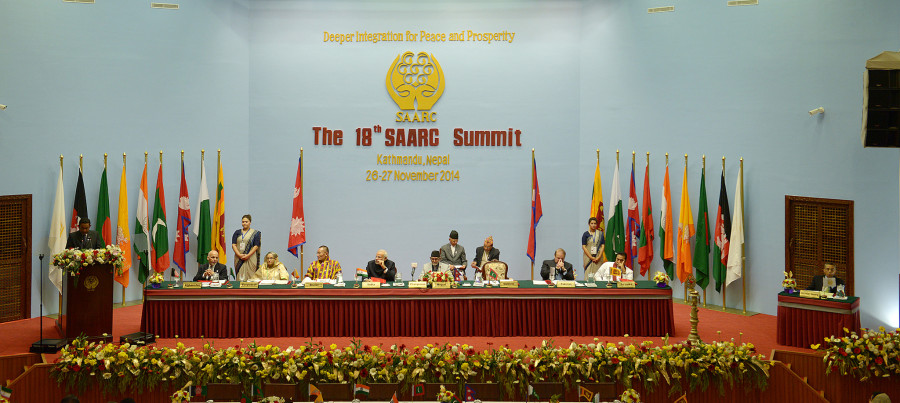Columns
Can climate diplomacy revive SAARC?
SAARC can play an influential role in responding to the impacts of extreme climate events.
Subash Pandey
Today, the United Nations Framework Convention on Climate Change (UNFCCC) and the global climate summits are the only spaces to discuss and declare climate ambitions. This has raised questions about the efficiency of the UNFCCC in delivering the results promised in the Paris Agreement (PA). There are arguments that moving forward with the implementation of the PA, climate diplomacy should focus on specific issues such as loss and damage and climate finance for South Asia, sectors, and geographies that can bring a meaningful difference as well as generate achievable climate ambitions. In this scenario, climate diplomacy could be that igniting force to revive the near-death South Asian Association for Regional Cooperation (SAARC) not only for the economic well-being of this region but also to set an example that other regions across the globe could follow to meet their ambitious climate goals.
Climate change impacts
South Asia is home to over one-fifth of the global population and is one of the most vulnerable regions to climate change. The increasing incidence and severity of floods, shrinking glaciers, rising sea levels, and water security coupled with livelihood dependent on agriculture and natural resources increase the vulnerability of communities and households to changing climate in this region. Multiple extreme climate events hit this region yearly with substantial economic and non-economic losses, including this year’s devastating flood in Pakistan and Bengaluru, India. Action Aid International and Climate Action Network research shows that climate-induced disasters will force 62 million South Asians to flee their home by 2050.
Not a single country can effectively respond to climate change and its associated extreme events in this region, mainly for two reasons. First, we share a common Hindu Kush Himalayan range which extends from Afghanistan in the West to Myanmar in the East, and rapidly melting glaciers will have spillover impacts in other countries. Similarly, we share cross-country water boundaries which impact both upstream and downstream countries during extreme rainfall during monsoon (even off-monsoon rainfall wreaks havoc in this region). Second, these extreme events exceed the capacity of a national government to respond timely and effectively, necessitating both immediate and long-term support from its neighbours. Therefore, SAARC can play an influential role not only in responding to the impacts of extreme climate events but also in achieving the ambitious climate actions proposed in their NDCs.
Climate diplomacy and revival of SAARC
SAARC was established in 1985 with the objective of regional cooperation, accelerating the social and economic development of the members, and maintaining peace and progress in the region. Despite its establishment more than three decades ago, South Asia remains one of the least integrated regions in the world, with the last SAARC summit being held in 2014. Against this backdrop, climate diplomacy can strengthen the relationship between governments through agreements and initiatives to tackle climate change. Climate change always intersects with other key important sectors in this region, such as agriculture and food security, energy, trade, technical cooperation, and security (including cross-country migration because of climate change). Hence, as explained in this article, climate diplomacy and science diplomacy might open avenues for countries in this region to cooperate to achieve the NDCs collectively.
The governments can come up with regional agreements and initiatives to mitigate the impacts of climate change. For example, they can set a sector-wise target, put relevant policies and agreements in place, and pull necessary financial resources towards that common goal. The two immediate sectors can be energy and security.
One ambitious regional goal could be to achieve net-zero emissions from the energy sector by 2040. India plans to reach the net-zero target by 2070, while other countries, including Nepal, have a target to reach net-zero by 2050. Regional cooperation in the energy sector might be a win-win situation for all countries. Energy is the primary greenhouse gases (GHGs) producing sector in Pakistan and India (the third largest GHGs emitting country in the world) and the second largest GHGs producing sector in Bangladesh, Bhutan, and Nepal. India meets its 55 percent of energy needs from coal, the most polluting source of energy.
Similarly, Bangladesh and Pakistan meet 57 percent and 64 percent of their energy demand from fossil fuels, including coal and natural gas. In Nepal and Bhutan, 77 percent and 83 percent of total energy needs are met from clean energy sources, respectively. Clean energy coming from hydropower will be surplus both in Bhutan and Nepal in the near future. Regional initiatives led by SAARC that invest in necessary infrastructures and policies might help in reliable energy trade between member countries of the SAARC.
Another important sector of regional cooperation will be security. There are a few initiatives to address natural disasters, such as SAARC Disaster Management Centre and Coastal Zone Management Centre. However, they are outdated in dealing with the scale of problems caused by climate change. Migration might be the only available escape from the failure of crops due to saltwater intrusion in low-lying countries (Bangladesh), entire communities inundated due to rising sea levels in the Maldives, and people who depend on daily wage labour in India being unable to work outside due to extreme heat waves. One study predicts that 60 million people will be homeless and displaced by climate-accelerated extreme events by 2050. The displacement will occur not only within the country but also across borders. This will be a matter of security concern for both countries of destination and origin. Establishing new initiatives that address such problems today under the SAARC is pertinent to prevent future clashes between countries.
Conclusion
SAARC has long been on the verge of death, unable to fulfil its core responsibility for which it was established. Due to geopolitical tension among its member countries, it has not been able to hold any summit since 2014. However, there is an urgent need to revive SARRC for a prosperous South Asia. The future prosperity of this region largely depends on how well we deal with the impacts of climate change. Additionally, research shows the importance of regional initiative beyond international climate diplomacy in meeting the goal of the Paris Agreement. Regional climate diplomacy could help revive the SAARC. Since the SARRC secretariat is in Kathmandu and Nepal is one of the most vulnerable countries to climate change, the country can spearhead regional climate diplomacy.




 7.12°C Kathmandu
7.12°C Kathmandu















